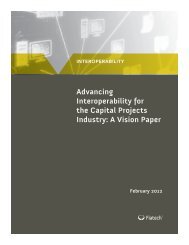An Introduction to ISO 15926 November 2011 - iRINGToday
An Introduction to ISO 15926 November 2011 - iRINGToday
An Introduction to ISO 15926 November 2011 - iRINGToday
Create successful ePaper yourself
Turn your PDF publications into a flip-book with our unique Google optimized e-Paper software.
The rest require some interpretation:<br />
Metric Data Sheet Imperial Data Sheet Comments<br />
Normal Flow Capacity: Normal Probably the same<br />
Rated Flow Capacity: Rated Probably the same<br />
Max. kPag Suction: Max. No data entry spot<br />
Differential Head Diff. Head: Rated Possibly the same<br />
NPSH Available NPSH Avail.: Rated Possibly the same<br />
Most mechanical engineers with a little experience will have no trouble figuring everything out<br />
because they have the rest of the project documents, and perhaps have experience with the<br />
pump manufacturer. Again, that is the point. We need humans <strong>to</strong> guide even what seem on<br />
the surface simple transcription tasks because our work practices depend <strong>to</strong> a great degree<br />
on context. However, when machines start talking directly <strong>to</strong> other machines the problem of<br />
implied meaning based on context becomes a serious barrier.<br />
The reason information exchange works these days is because we exchange entire sets of data<br />
(for instance, a complete data sheet) in which the context is preserved. The disadvantage,<br />
however, is precisely that: we have <strong>to</strong> exchange entire sets of data and we must have humans<br />
interpret them item by item. What we really want is <strong>to</strong> be able <strong>to</strong> let machines exchange information<br />
directly without having <strong>to</strong> rely on context <strong>to</strong> retain the correct meaning. What we really<br />
need is a “cut-and-paste” <strong>to</strong>ol for plant information. We want <strong>to</strong> be able <strong>to</strong> just “cut it from that<br />
database over there” and “paste it <strong>to</strong> this database over here.” However, it’s not that simple.<br />
The first and most obvious reason we cannot use a simple cut-and-paste <strong>to</strong>ol is that the data<br />
values we want <strong>to</strong> transfer seldom map <strong>to</strong> the same (x,y) coordinates on any two data sheets.<br />
In order <strong>to</strong> know which data values <strong>to</strong> transfer, we have <strong>to</strong> first know enough about the data<br />
sheets and underlying databases <strong>to</strong> know which values are required, which values can be ignored,<br />
and whether or not something is missing.<br />
The second reason is, as we have seen in this example, we cannot rely on the name of the attributes.<br />
Even when attributes in two databases have the same name, we cannot be sure there<br />
are no subtle differences in their meaning. We need a human expert <strong>to</strong> confirm that the attributes<br />
match. These actions are trivial if you have the right context. We have many thousands<br />
of design engineers doing this all day, every day, and generally they are good at it. However,<br />
we rely so much on context <strong>to</strong> convey meaning that we cannot trust machines <strong>to</strong> make the<br />
right decisions on their own.<br />
Finally, this is all carried out in the context of the same written language. What would happen<br />
if the project were engineered in English but the client wanted all of his data sheets turned<br />
over in Russian?<br />
The Value of the <strong>ISO</strong> <strong>15926</strong> Dictionary<br />
When we want <strong>to</strong> exchange information between two software applications, the traditional<br />
way is <strong>to</strong> map the respective databases <strong>to</strong>gether. We preserve the context by manually examining<br />
the terms in each database <strong>to</strong> determine which are equivalent. Directly mapping two<br />
applications <strong>to</strong>gether is often the easiest short-term solution.<br />
CHAPTER 1<br />
18



